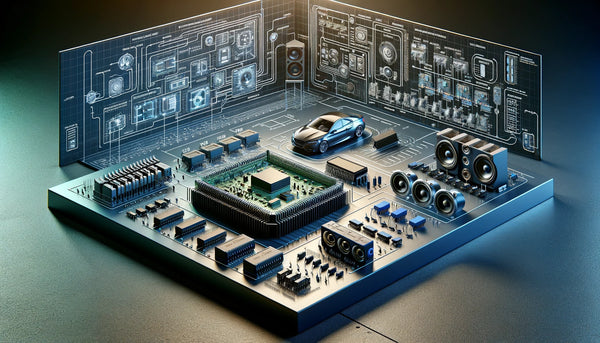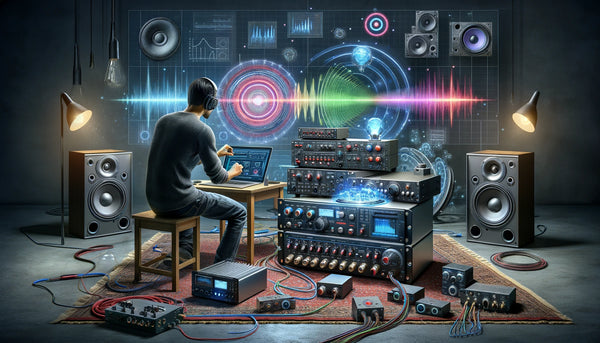
Unlocking DSP: Secrets to Digital Signal Processing
Key Highlights
- Digital Signal Processing (DSP) is a technique used to improve the accuracy and reliability of digital communications.
- DSP involves multiple mathematical operations such as compression, decompression, filtering, equalization, modulation, and demodulation to generate a signal of superior quality.
- DSP is used in communications systems, audio and speech processing, sonar and radar systems, sensor arrays, image enhancement, telecommunications, system controls, and even the biomedical field.
- DSP offers various benefits, including audience targeting capabilities, brand safety, and fraud prevention tools, a real-time view of campaign performance, optimizations, and flexible budget shifting.
- Choosing the suitable DSP depends on the data type needed, the number of ad exchanges the DSP is plugged into, cost, training and support, and ease of use.
Introduction
Digital Signal Processing (DSP) is a powerful technique that has revolutionized how we process and manipulate digital signals. From improving audio and video quality to enhancing communication systems, DSP plays a crucial role in various industries and technologies.
At its core, DSP involves mathematical operations to manipulate digital signals, such as compression, decompression, filtering, equalization, modulation, and demodulation. DSP systems perform These operations rapidly and accurately, resulting in signals of superior quality and reliability.
The evolution of DSP has led to significant advancements in modern technology. With the development of digital signal processors (DSPs), DSP systems' processing power and efficiency have greatly improved. These specialized chips are designed to perform complex mathematical operations quickly and efficiently, making DSP technology more accessible and widely used.
This blog will explore the basics of digital signal processing, including its core competencies and fundamental concepts. We will also delve into the critical applications of DSP across industries, such as communication systems and audio enhancement. Additionally, we will demystify DSP systems' architecture and analyze converters' role in signal processing.
By unlocking the secrets of DSP, we can gain a deeper understanding of its capabilities and unleash its potential in various fields of technology.
Exploring the Basics of Digital Signal Processing (DSP)

Signal processing is manipulating and analyzing signals to extract meaningful information or enhance their quality. Digital signal processing (DSP) refers explicitly to the processing of digital signals, which are represented as a sequence of discrete values. DSP techniques are used to improve the accuracy and reliability of digital communications.
Digital signal processing has several core competencies, making it a powerful tool in various applications. One of its critical competencies is the ability to perform mathematical operations on digital signals. These operations include compression, decompression, filtering, equalization, modulation, and demodulation. By manipulating the digital signals through these operations, DSP can generate signals of superior quality.
Another core competency of DSP is its ability to differentiate between orderly signals and noise. DSP algorithms can help identify and remove noise from a signal, improving its overall quality. This is especially important in communication systems where noise can interfere with the transmission and reception of information.
Error detection and correction is another crucial aspect of DSP. By implementing error detection algorithms, DSP systems can identify and correct errors in digital signals, ensuring the integrity and accuracy of the transmitted data. This is crucial in applications where data integrity is paramount, such as telecommunications and data transmission systems.
In addition to these core competencies, DSP can analyze and process signals in real time. This is particularly useful in applications requiring immediate action, such as speech recognition, audio and video processing, and real-time analytics.
Overall, digital signal processing is a versatile and powerful tool that has revolutionized how we process and manipulate digital signals. Its core competencies make it an essential technology in various fields, from communication systems to audio and video enhancement.
The Evolution and Importance of DSP in Modern Technology
The evolution of digital signal processing (DSP) has played a significant role in shaping modern technology. Digital signal processors (DSPs) are specialized chips designed to perform complex mathematical operations on digital signals quickly and efficiently. These processors have greatly improved DSP systems' processing power and efficiency, making them more accessible and widely used in various industries.
The importance of DSP in modern technology cannot be overstated. DSP techniques are used in various applications, including communication systems, audio and video processing, image enhancement, telecommunication systems, biomedical engineering, and more. DSP technology has revolutionized these fields by enabling the manipulation and analysis of digital signals with unparalleled accuracy and speed.
DSP is responsible for enhancing speech quality, reducing noise, and optimizing data transmission in communication systems. In audio and video processing, DSP techniques enhance sound and image quality, remove noise, and apply various effects. In image enhancement, DSP algorithms can improve the clarity and resolution of images and videos. In telecommunication systems, DSP is used for data compression, error detection and correction, and modulation and demodulation.
The evolution of DSP technology continues to drive innovation and transform various industries. DSP is expected to play an even more significant role as technology advances in areas such as artificial intelligence, machine learning, real-time analytics, and more. The future of DSP holds immense potential for further advancements and applications in modern technology.
Fundamental Concepts and Components of DSP
Digital signal processing (DSP) involves several fundamental concepts and components essential to understanding its capabilities and applications. One of the critical concepts in DSP is the digital signal itself, a sequence of discrete values representing a continuous signal. These discrete values are processed using mathematical algorithms to manipulate and analyze the signal.
Algorithms are at the core of DSP, as they determine how the digital signal is processed. These algorithms can perform various operations such as compression, decompression, filtering, equalization, modulation, and demodulation. DSP can enhance its quality and extract meaningful information by applying these algorithms to the digital signal.
Error detection is a crucial component of DSP. DSP systems use error detection algorithms to identify and correct errors in the digital signal. This ensures the integrity and accuracy of the transmitted data. Error detection is critical in applications where data integrity is critical, such as telecommunications and data transmission systems.
In addition to error detection, DSP also uses algorithms for error correction. These algorithms can correct errors in the digital signal, improving the system's overall reliability. Error correction techniques, such as medical imaging and data storage systems, are essential in applications where data accuracy is paramount.
Overall, DSP's fundamental concepts and components, including digital signals, algorithms, and error detection, are crucial to its operation and effectiveness. These concepts form the foundation of DSP technology and enable its wide applications across industries.
Critical Applications of DSP Across Industries

- Revolutionizing Communication with DSP Techniques:
- Speech processing and recognition
- Data compression for efficient transmission
- Noise reduction and echo cancellation for clearer audio
- Enhancing Audio and Video Quality through Advanced DSP:
- Improving sound quality in audio recordings
- Creating audio effects in music production
- Video enhancement and restoration
- Demystifying the DSP System Architecture:
- Understanding signal flow and processing blocks
- Analyzing the role of converters in DSP systems
- Delving into DSP for Audio Enhancement:
- Noise reduction and echo cancellation in audio
- DSP effects in music production and sound engineering
Revolutionizing Communication with DSP Techniques
DSP techniques have revolutionized communication systems by enhancing speech quality, improving data transmission efficiency, and enabling advanced features such as noise reduction and data compression. Some of the critical applications of DSP in communication include:
- Speech Processing and Recognition:
- DSP algorithms can analyze and interpret speech signals, enabling voice recognition and speech synthesis applications.
- Speech enhancement techniques can improve speech quality by reducing background noise and enhancing clarity.
- Echo cancellation algorithms eliminate echoes in communication systems, improving audio quality and intelligibility.
- Data Compression for Efficient Transmission:
- DSP algorithms can compress data by removing redundant information, resulting in smaller file sizes and faster transmission.
- Compression techniques such as Huffman coding and Lempel-Ziv-Welch (LZW) algorithm are commonly used in data compression.
- Noise Reduction and Echo Cancellation for Clearer Audio:
- DSP algorithms can analyze and filter out unwanted noise from audio signals, making clearer and more intelligible communication.
- Echo cancellation techniques eliminate echoes caused by sound reflections, improving the quality of voice calls and conferences.
By leveraging DSP techniques, communication systems can deliver clearer audio, optimize data transmission, and enhance the overall user experience. DSP has transformed communication, enabling seamless and efficient communication across various platforms and devices.
Enhancing Audio and Video Quality through Advanced DSP
DSP has revolutionized the audio and video industry by enabling advanced sound and image quality enhancement techniques. Some of the critical applications of DSP in audio and video enhancement include:
- Improving Sound Quality in Audio Recordings:
- DSP algorithms can enhance audio recordings' clarity, richness, and balance, producing higher-quality sound.
- Equalization techniques can adjust the frequency response of audio signals, allowing for better tonal balance and fidelity.
- Noise reduction algorithms can effectively remove background noise from audio recordings, improving the listening experience.
- Creating Audio Effects in Music Production:
- In music production, DSP techniques apply audio effects such as reverb, delay, chorus, and pitch correction.
- DSP algorithms can manipulate audio signals to create unique sounds, add spatial effects, and enhance the overall depth and richness of the music.
- Video Enhancement and Restoration:
- DSP algorithms can enhance video signals' clarity, sharpness, and color accuracy, resulting in improved video quality.
- Image stabilization techniques can remove unwanted motion blur and camera shake from video recordings, resulting in smoother and more stable footage.
- Digital video processing algorithms can restore old or degraded video footage, improving its visual quality and reducing noise and artifacts.
By leveraging advanced DSP techniques, audio and video professionals can achieve higher-quality sound and visuals, resulting in an immersive and engaging experience for the audience.
Demystifying the DSP System Architecture

DSP systems are built on a specific architecture that enables the processing of digital signals. Understanding the system architecture is essential for effectively designing and implementing DSP solutions. Critical aspects of the DSP system architecture include signal flow and processing blocks, as well as the role of converters in converting analog signals to digital form and vice versa. By demystifying the DSP system architecture, we can gain insights into how DSP systems operate and how they can be optimized for various applications.
Understanding Signal Flow and Processing Blocks
Signal flow and processing blocks are integral components of the DSP system architecture. Signal flow refers to a digital signal's path through the DSP system, from the input to the output. This path is determined by the DSP system's processing blocks and modules that perform specific operations on the digital signal.
The signal flow in a DSP system typically follows a sequential order, with the digital signal being processed by various blocks before reaching the output. Each processing block performs a specific operation on the digital signal, such as filtering, equalization, or modulation. Complex operations can be performed on the digital signal by chaining these processing blocks together.
The system architecture of a DSP system determines the organization and arrangement of these processing blocks. The architecture can vary depending on the specific application and requirements of the DSP system. Common architectures include the single instruction, multiple data (SIMD) architecture and the multiple instruction, multiple data (MIMD) architecture.
Understanding a DSP system's signal flow and processing blocks is crucial for effectively designing and implementing DSP solutions. The performance and efficiency of the DSP system can be maximized by optimizing the signal flow and selecting the appropriate processing blocks.
Analyzing the Role of Converters in DSP Systems
Converters play a crucial role in DSP systems by converting analog signals to digital form and vice versa. These converters enable the seamless integration of digital and analog signals, allowing for the processing and manipulating real-world signals in DSP systems.
Analog-to-digital converters (ADCs) convert continuous analog signals into discrete digital signals. These converters randomly sample the analog signal and assign a digital value to each sample. The resulting digital signal consists of a sequence of discrete values representing the original analog signal.
Digital-to-analog converters (DACs) perform the opposite function, converting discrete digital signals back into continuous analog signals. These converters reconstruct the analog signal from the discrete digital values by outputting a continuous voltage or current corresponding to each digital sample.
The role of converters in DSP systems is crucial for several reasons. Firstly, they enable the digitization of real-world signals, allowing for the application of DSP algorithms and processing techniques. Secondly, converters enable the conversion of processed digital signals back into analog form, making them compatible with analog output devices such as speakers and displays.
Overall, converters are essential components of DSP systems, facilitating the seamless integration of digital and analog signals and enabling the processing and manipulation of real-world signals.
|
Column Name A |
Column Name B |
|
Analog-to-digital converters (ADCs) |
Convert continuous analog signals to discrete digital signals |
|
Digital-to-analog converters (DACs) |
Convert discrete digital signals back into continuous analog signals |
Delving into DSP for Audio Enhancement

DSP techniques are widely used in audio enhancement applications to improve sound quality, reduce noise, and apply various effects. By delving into the world of DSP for audio enhancement, we can uncover the secrets behind noise reduction, echo cancellation, and the application of DSP effects in music production and sound engineering.
The Magic Behind Noise Reduction and Echo Cancellation
Noise reduction and echo cancellation are two critical techniques DSP uses for audio enhancement. These techniques can significantly improve the quality and clarity of audio recordings by removing unwanted noise and echo.
Noise reduction algorithms in DSP systems analyze audio signals and identify frequencies corresponding to noise. By applying filters to these frequencies, the noise can be effectively reduced or eliminated, resulting in cleaner and more intelligible audio.
Echo cancellation algorithms eliminate echoes in audio recordings caused by sound reflections. When sound is transmitted and received in an enclosed space, such as a room, echoes can occur and degrade the audio quality. Echo cancellation algorithms analyze the time delay and amplitude of the echoes and generate a cancellation signal subtracted from the original audio signal, effectively eliminating the echoes.
By leveraging these noise reduction and echo cancellation techniques, DSP systems can enhance the audio quality of recordings, making them more enjoyable to listen to and improving the overall user experience.
Exploring DSP Effects in Music Production and Sound Engineering
DSP effects play a vital role in music production and sound engineering, allowing producers and engineers to enhance the sonic characteristics of recordings creatively. DSP effects can be applied to individual tracks or the overall mix, enabling various creative possibilities.
Some common DSP effects used in music production include:
- Reverb: Adds the perception of space and creates a sense of depth in recordings.
- Delay: Creates echoes and repeats of audio signals, adding a sense of space and rhythm.
- Chorus: Creates a thickening effect by duplicating and slightly detuning audio signals.
- Equalization: Adjusts the frequency response of audio signals to enhance tonal balance.
- Compression: Controls the dynamic range of audio signals, making softer sounds louder and reducing the volume of louder sounds.
These DSP effects can be combined and manipulated to create unique sounds and sonic landscapes. Sound engineers and music producers use DSP effects to shape the overall sound of recordings, adding depth, dimension, and character.
DSP technology has revolutionized music production and sound engineering, enabling endless creative possibilities and pushing the boundaries of sonic exploration.
Conclusion
Digital Signal Processing (DSP) is a transformative technology shaping various industries. Its applications are diverse and impactful, from revolutionizing communication to enhancing audio quality. Understanding the system architecture and processing blocks is crucial for grasping its potential fully. Delve into DSP for audio enhancement, exploring noise reduction and effects in music production. Unravel the differences between DSP and analog processing and its role in AI and streaming services. Stay ahead with future trends in DSP technology. For more in-depth insights, redirect to another blog.
Frequently Asked Questions
What is the Difference Between DSP and Analog Signal Processing?
DSP and analog signal processing are two different approaches to manipulating and analyzing signals. At the same time, analog signal processing operates on continuous analog signals, and DSP processes discrete digital signals. DSP offers advantages in speed, accuracy, and the ability to perform complex mathematical operations.
How Does DSP Contribute to AI and Machine Learning?
DSP plays a significant role in AI and machine learning by providing the computational power and algorithms necessary for processing and analyzing large amounts of data. DSP enables optimizing machine learning algorithms, allowing for efficient training and inference processes in AI systems.
Can DSP Improve the Quality of Streaming Services?
Yes, DSP can significantly improve the quality of streaming services. DSP techniques such as data compression and error detection and correction enhance the efficiency and reliability of streaming platforms, resulting in improved audio and video quality for users.
What are the Future Trends in DSP Technology?
The future of DSP technology holds exciting possibilities. Some key trends include advancements in real-time analytics, integrating DSP with emerging technologies such as artificial intelligence and machine learning, and continuous innovation in DSP algorithms and architectures.

















